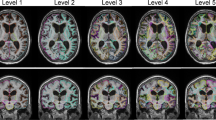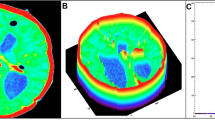Abstract
Purpose
To recommend a new simple and explicit index termed the anteroposterior diameter of the lateral ventricle index (ALVI) for assessing brain ventricular size in neuroimaging and to compare Evans index (EI) between idiopathic normal pressure hydrocephalus (iNPH) patients and age-matched healthy elderly subjects.
Methods
Retrospective measurements of ventricular volume (VV), relative VV (RVV), the EI, and the ALVI were taken from thin-section CT scans for 23 pre-shunt-insertion iNPH patients and 62 age-matched healthy elderly volunteers. The area under the receiver operating characteristic (ROC) curve (AUC), net reclassification improvement (NRI), and integrated discrimination improvement (IDI) were calculated to assess the effectiveness of ALVI scores for predicting VV.
Results
The correlations between VV or RVV and ALVI scores (VV, r = 0.957; RVV, r = 0.983) were significantly stronger than the corresponding correlations with EI scores (VV, r = 0.843; RVV, r = 0.840). The AUC for ALVI scores was significantly greater than the AUC for EI scores. Furthermore, with the inclusion of the ALVI, the NRI value was 0.14 and the IDI value was 0.14; these improvements were also statistically significant.
Conclusion
The ALVI is a more accurate and more explicitly defined marker of VV than the EI and assesses ventricular enlargement effectively. We suggest that ventricular enlargement of the healthy elderly be defined by ALVI > 0.50.




Similar content being viewed by others
References
Adams R, Fisher C, Hakim S, Ojemann R, Sweet W (1965) Symptomatic occult hydrocephalus with normal cerebrospinal-fluid pressure — a treatable syndrome. N Engl J Med 273:117–126
Relkin N, Marmarou A, Klinge P, Bergsneider M, Black PM (2005) Diagnosing idiopathic normal-pressure hydrocephalus. Neurosurgery 57:S4–S16
Mori E, Ishikawa M, Kato T, Kazui H, Miyake H, Miyajima M, Nakajima M, Hashimoto M, Kuriyama N, Tokuda T, Ishii K, Kaijima M, Hirata Y, Saito M, Arai H (2012) Guidelines for management of idiopathic normal pressure hydrocephalus: second edition. Neurol Med Chir (Tokyo) 52:775–809
Williams MA, Relkin NR (2013) Diagnosis and management of idiopathic normal-pressure hydrocephalus. Neurol Clin Pract 3:375–385
Jr EW (1942) An encephalographic ratio for estimating the size of the cerebral ventricles - further experience with serial observations. Am J Dis Child 64:820–830
Toma AK, Holl E, Kitchen ND, Watkins LD (2011) Evans' index revisited: the need for an alternative in normal pressure hydrocephalus. Neurosurgery 68:939–944
Skullerud K (1985) Variations in the size of the human brain. Influence of age, sex, body length, body mass index, alcoholism, Alzheimer changes, and cerebral atherosclerosis. Acta Neurol Scand Suppl 102:1–94
Agartz I, Marions O, Saaf J, Wahlund LO, Wetterberg L (1992) Visual rating of magnetic resonance images of human cerebrospinal fluid spaces and white brain matter: relation to sex and age in healthy volunteers. Magn Reson Imaging 10:135–142
Giedd JN, Castellanos FX, Rajapakse JC, Vaituzis AC, Rapoport JL (1997) Sexual dimorphism of the developing human brain. Prog Neuro-Psychopharmacol Biol Psychiatry 21:1185–1201
Coffey CE, Lucke JF, Saxton JA, Ratcliff G, Unitas LJ, Billig B, Bryan RN (1998) Sex differences in brain aging: a quantitative magnetic resonance imaging study. Arch Neurol 55:169–179
Ambarki K, Israelsson H, Wahlin A, Birgander R, Eklund A, Malm J (2010) Brain ventricular size in healthy elderly: comparison between Evans index and volume measurement. Neurosurgery 67(94–99):99
Pencina MJ, D'Agostino RS, D'Agostino RJ, Vasan RS (2008) Evaluating the added predictive ability of a new marker: from area under the ROC curve to reclassification and beyond. Stat Med 27(157–172):207–212
Brix MK, Westman E, Simmons A, Ringstad GA, Eide PK, Wagner-Larsen K, Page CM, Vitelli V, Beyer MK (2017) The Evans’ index revisited: new cut-off levels for use in radiological assessment of ventricular enlargement in the elderly. Eur J Radiol 95:28–32
Jaraj D, Rabiei K, Marlow T, Jensen C, Skoog I, Wikkelso C (2017) Estimated ventricle size using Evans index: reference values from a population-based sample. Eur J Neurol 24:468–474
Jaraj D, Rabiei K, Marlow T, Jensen C, Skoog I, Wikkelso C (2014) Prevalence of idiopathic normal-pressure hydrocephalus. Neurology 82:1449–1454
Nestor SM, Rupsingh R, Borrie M, Smith M, Accomazzi V, Wells JL, Fogarty J, Bartha R (2008) Ventricular enlargement as a possible measure of Alzheimer’s disease progression validated using the Alzheimer’s disease neuroimaging initiative database. Brain 131:2443–2454
Palm WM, Walchenbach R, Bruinsma B, Admiraal-Behloul F, Middelkoop HA, Launer LJ, van der Grond J, van Buchem MA (2006) Intracranial compartment volumes in normal pressure hydrocephalus: volumetric assessment versus outcome. AJNR Am J Neuroradiol 27:76–79
Palm WM, Saczynski JS, van der Grond J, Sigurdsson S, Kjartansson O, Jonsson PV, Eiriksdottir G, Gudnason V, Admiraal-Behloul F, Launer LJ, van Buchem MA (2009) Ventricular dilation: association with gait and cognition. Ann Neurol 66:485–493
Funding
This study was funded by the Project of Shenzhen International Cooperation Foundation (GJHZ20180926165402083).
Author information
Authors and Affiliations
Corresponding author
Ethics declarations
Conflict of interest
The authors declare that they have no conflict of interest.
Ethical approval
All procedures performed in studies involving human participants were in accordance with the ethical standards of the institutional and/or national research committee and with the 1964 Helsinki declaration and its later amendments or comparable ethical standards.
Informed consent
Informed consent was obtained from all individual participants included in the study.
Additional information
Publisher’s note
Springer Nature remains neutral with regard to jurisdictional claims in published maps and institutional affiliations.
Rights and permissions
About this article
Cite this article
He, W., Fang, X., Wang, X. et al. A new index for assessing cerebral ventricular volume in idiopathic normal-pressure hydrocephalus: a comparison with Evans’ index. Neuroradiology 62, 661–667 (2020). https://doi.org/10.1007/s00234-020-02361-8
Received:
Accepted:
Published:
Issue Date:
DOI: https://doi.org/10.1007/s00234-020-02361-8




